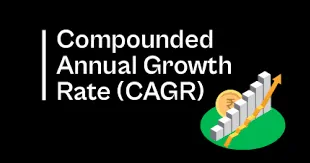What Is CAGR? A Simple Guide to Understanding Compound Annual Growth Rate
It provides a smooth annual rate of growth and is vital for comparing the performance of investments in different securities.

Investments often hinge upon understanding various financial indicators and metrics. One such crucial measure is the Compound Annual Growth Rate, commonly abbreviated as CAGR. For investors, both novices and experts, grasping the CAGR meaning is essential to assess the performance of investments over a period. It provides a smooth annual rate of growth and is vital for comparing the performance of investments in different securities.
Understanding CAGR Meaning
CAGR meaning is a financial metric used to describe the geometric progression ratio that provides a constant rate of return over a period. Unlike absolute returns, which can be misleading, CAGR considers the compounding effect, making it a more accurate indicator of an investment’s growth over time. The formula for calculating CAGR is:
[CAGR} =left( frac[{Ending Value}}{Beginning Value}} ight)^{\frac{1}{n}} - 1 ]
Where:
- Ending Value is the value of the investment at the end of the period.
- Beginning Value is the value at the start of the period.
- n is the number of years.
For example, if an investor placed ₹100,000 in a fund and three years later the investment is worth ₹150,000, the CAGR is calculated as follows:
[ {CAGR} = left( frac{150,000}{100,000} \right)^{\frac{1}{3}} - 1 = (1.5)^{\frac{1}{3}} - 1 \approx 14.47\% ]
This indicates that the investment grew at an annual compounded rate of approximately 14.47% over three years.
Advantages of CAGR
- Simplicity: CAGR reduces complex annual growth figures into a single annual growth rate. This enables easy comparison across various investments.
- Comprehensiveness: By factoring in the compounding effect, CAGR provides a comprehensive measure of investment performance.
- Comparative Analysis: Investors can compare the CAGR of different investment options, giving them a clearer picture of performance over time.
CAGR vs. Sharpe Ratio
While CAGR provides insights into an investment's growth rate, it does not consider risk. This is where the Sharpe Ratio becomes relevant. The Sharpe Ratio is a measure used to assess the risk-adjusted return of an investment. It indicates how much return an investor receives for the risk taken.
To calculate the Sharpe Ratio, you use the formula:
[ {Sharpe Ratio} = frac {Average Return of the Investment} - {Risk-Free Rate}}
[{Standard Deviation of the Investment's Return}} ]
Where:
- Average Return of the Investment is the average annual return.
- Risk-Free Rate is the return of an investment with zero risk, often taken as government bond yields.
- Standard Deviation indicates the investment's volatility.
CAGR, focusing solely on growth, is less insightful when considering an investment's overall performance related to risk. Evaluating both CAGR and the Sharpe Ratio can provide a more rounded view of investment performance.
Real-World Application of CAGR
Understanding CAGR is crucial for anyone involved in the financial markets, particularly in India, where market volatility can influence investment decisions. For example, if an investor evaluates mutual funds, knowing each fund's CAGR over the past five years can offer insights into which fund has historically provided better compounded growth.
Moreover, companies often declare their CAGR to present their financial growth trajectory in annual reports, aiding stakeholders in decision-making processes.
Potential Drawbacks
Despite its advantages, CAGR assumes that growth happens at a uniform rate, which can sometimes provide an oversimplified view. Real-world investments experience volatility, and CAGR does not reflect interim fluctuations or any negative growth over shorter periods within the investment tenure.
Summary
CAGR is a pivotal tool for investors seeking to understand the average annual growth rate of their investments. It provides a clear and concise measure that can simplify decision-making processes. However, it should not be used in isolation, especially when weighing the risk-return paradigm, which is where tools like the Sharpe Ratio come into play.
Disclaimer: The Indian financial market is intricate and dynamic. Investors should meticulously assess all relevant factors, including risk levels and market conditions, before making investment decisions. The CAGR and Sharpe Ratio are powerful tools, but they form part of a broader evaluative process. Financial advice should be tailored to individual circumstances, considering the specific financial goals and risk tolerance.
---
Summary: What Is CAGR? A Simple Guide to Understanding Compound Annual Growth Rate
The Compound Annual Growth Rate (CAGR) serves as a crucial financial metric for evaluating and comparing investment growth over time. Understanding the CAGR meaning is vital for investors aiming to determine the annual compounded rate of return across several years, providing clarity amid varied investment choices. Unlike simple annual returns, CAGR reflects the benefit of compounding, offering a more precise performance measure.
Utilizing a consistent growth rate via CAGR allows investors to streamline complex growth data, providing an essential comparison metric across different investment landscapes. However, CAGR offers no insights into the risk associated with the investments, which is why pairing it with risk measures like the Sharpe Ratio is recommended for a balanced investment analysis.
Despite its advantages, CAGR does assume constant growth, disregarding possible dips and fluctuations typical in real-world investments. Therefore, while CAGR helps cement understanding in financial performance evaluations, it requires complementary analysis tools to fully gauge investment potential and risks—crucial for strategic decision-making within the Indian financial market.
What's Your Reaction?














